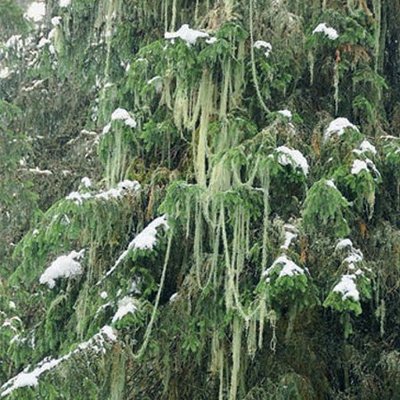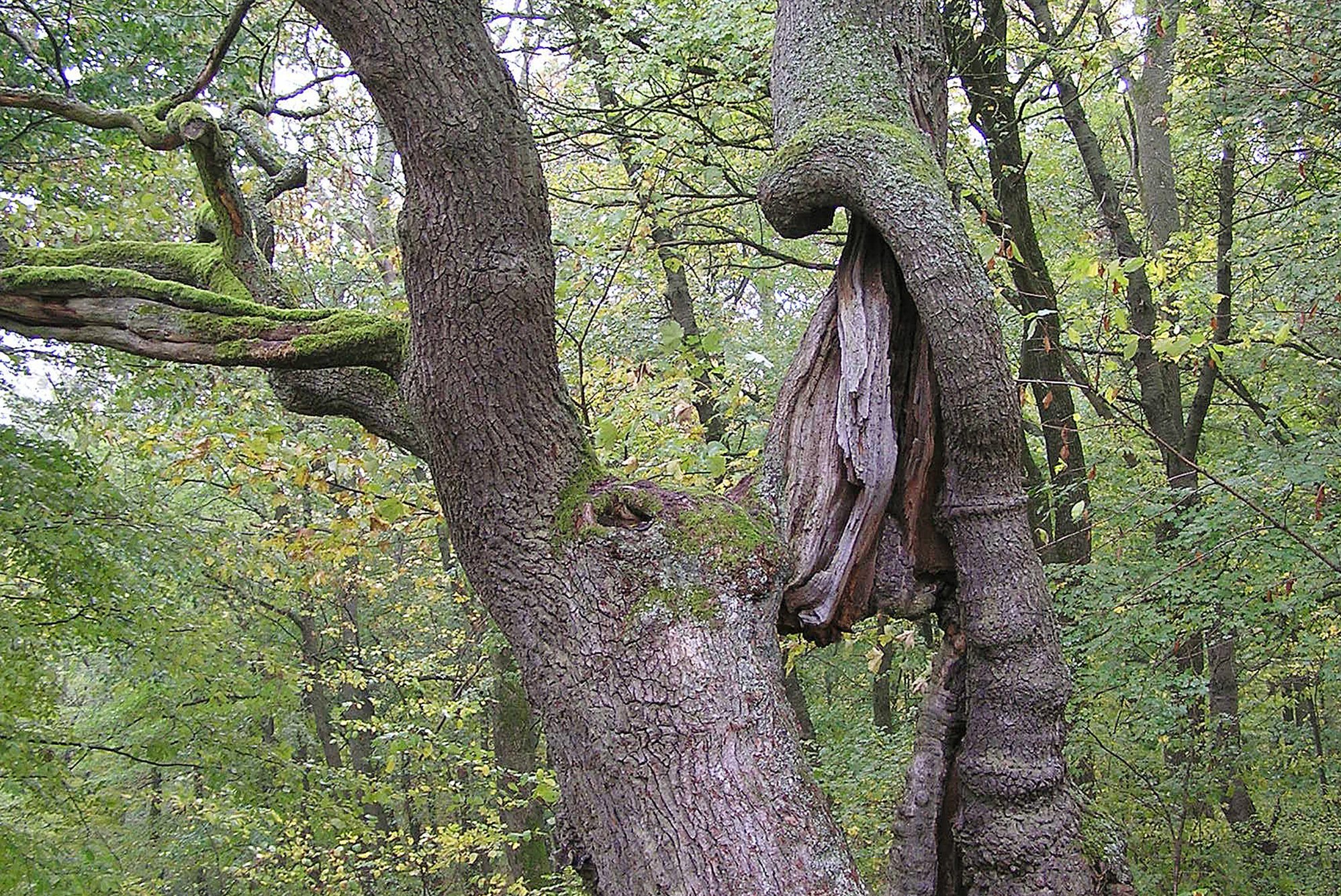
Fig. 1. The old man’s beard (or Methuselah’s beard) lichen (Usnea longissima), which is very rare in Switzerland, is bound to habitats with high air humidity. It is dependent on ecological continuity. Photo: Christoph Scheidegger (WSL)
There are known to be almost 1800 lichen species in Switzerland, 621 of which are dependent on the forest habitat. Of these forest species, 134 are priority species, which require special measures to ensure their long-term conservation. Various international studies have shown that the species diversity of tree-dwelling lichens is influenced by the predominant tree species, the diversity of tree species, the climatic conditions, the stand structure and the diameter of the trunks on which they occur.
Although lichens can occur on trees of all age classes, almost three quarters of forest lichen species are bound to microhabitats and structures that are considered to be phenological ageing characteristics of trees and that are restricted to thick trunks or old trees. Such species are referred to below as old-tree lichens.
What are lichens?
The term lichen refers to a symbiosis between a fungus and one or more photosythesising partners, whereby the symbiosis is beneficial for both partners. The fungal partners are tubular fungi; the photosynthesising partners are green algae or cyanobacteria.
The properties of lichens differ significantly from those of the organisms they are composed of. Lichens also colonise dry and hot rocks that are exposed to the sun, for example, where fungi or algae can hardly occur.
Source: Wikipedia, modified
Lichens on thick trunks or old trees
Scientists have found significant differences between old-tree lichens and other lichen species in terms of the dimensions of the trees they colonised. Both the minimum and the mean diameter at breast height (BHD) of the trees colonised by old-tree lichens were significantly larger than those of the trees colonised by other lichen species. Interestingly, the maximum BHDs of the trees colonised by old-tree lichens are not any larger, which suggests that most lichen species can also grow on very thick trunks. To become established on trees, endangered forest lichens (categories CR, EN and VU of the Red Lists) also require significantly larger trunk diameters than non-endangered species (LC and NT).
The association of numerous lichen species with large-dimensioned or old trees can be explained by the fact that thick trunks with cracked bark often offer microhabitats and structures that only develop successively as the trees age. Typically, the species diversity of tree-dwelling lichens on individual trees will therefore increase with tree age. The higher number of species on older trees is however not so much the result of the additional surface area offered by the thicker trunk or the early accumulation of species on the trunk, but of the presence of a greater variety of structures.
Microhabitats that only develop with increasing tree age can be described as key structures because of their importance as habitats for lichens. Key structures like this are usually characterised by some very specific features required of a site by lichens. For example, inclining trunks have one side that remains moist for longer, favoured by an above-average amount of trunk run-off water. This enables the alternating wet-dry lichens to remain physiologically active for longer. The rotting bark of old trees has a similar effect, as it has an increased water storage capacity. Other lichens, on the other hand, have specialised in drier locations, growing only in microhabitats protected from the rain, such as the lower sides of trunks, or bark cracks. Examples of key structures that are of particular importance as habitats for lichens are listed in Table 1.
| Key structure | Specific ecological characteristics | Examples |
| Tree species | Bark pH value, nutrient content and bark exudates with a partially allelopathic effect | Bactrospora dryina on Quercus sp., Rinodina isidioides on Castanea sativa, Bacidia friesiana on Sambucus nigra |
| Thin branches in shaded crown parts | Faster absorption of moisture from fog; protection from direct sunlight | Ochrolechia szatalaensis, Bryoria capillaris, B. implexa, Ramalina thrausta |
| Slightly inclined trees (5-15° deviation from the plumb line) | Highly variable availability of trunk run-off water: inclined surface remains moist longer due to trunk run-off water and being rained on directly; the lower trunk side offers some protection from rain | Inclined surface: Lobaria pulmonaria, Sticta fuliginosa, Agonimia allobata; Upper stem side: Bactrospora dryina, Arthonia byssacea |
| Growth of mosses or microbial crusts | Biological interactions, increased water availability | Normandina acroglypta, N. pulchella, Fellhanera gyrophorica |
| Old bark | Lower acidity, partially increased water storage capacity | Arthonia vinosa, Thelotrema lepadinum, Thelopsis rubella, Fellhaneropsis vezdae |
| Bark injury, biotic and abiotic | Increase in pH value and nutrient availability | Many species, no specific species in Switzerland |
| Bark cracks and bark ridges | Protection from being rained on directly, increased air humidity, diffuse lighting | Chaenotheca sp. div., Calicium sp. div., Caloplaca lucifuga |
| Standing deadwood (insufficiently studied in Switzerland) | Smooth wood corpuses exposed after the bark has fallen off are the habitat of crustose lichens, which are usually competitively weak and can often only develop extensively in this habitat. Characteristic species on deciduous and coniferous trees | Species of the genera Micarea, Calicium |
| Charred wood on standing trees | Changed chemical composition of the substrate, exclusion of competitors | Species of the genus Hypocoenomyce |
| Lying deadwood (insufficiently studied in Switzerland) | Different stages of decomposition - from early stages of rot to peat-like decay - provide habitats for tree species-specific lichen communities | Cladonia, Micarea, Anzina carneonivea, Protothelenella leucothelia |
| Rocky areas (insufficiently studied in Switzerland) | Rocky areas in the forest with different degrees of shade have characteristic lichen communities | Parmelina, Parmotrema, Gomphillus calycioides, Psilolechia lucida |
| Earth surfaces without litter cover | Often dominated by lichens, especially in alternately dry locations | Cladonia, Peltigera, Thelocarpon imperceptum |
| Stand structure and degree of mixing | Complex horizontal and vertical stand structures enable rapidly changing light conditions during the course of the day and year. Photosynthesis favoured by spots of light wandering over lichen sites | Lobaria amplissima, Usnea, Bryoria |
Lichens in old-growth forests
As symbiotic organisms, lichens have developed complex biological dispersal strategies. Lichen species that spread by means of unicellular spores are among the most common colonisers of isolated trees in open landscapes. The wind carries the spores over long distances.
In addition to the sexual reproduction of the fungal partner by means of spores, lichens can also develop symbiotic dispersal units (soredia and isidia) that contain both the fungal partner and the algal partner. This has the advantage that the soredia and isidia grow back into a lichen on a suitable substrate because both symbiotic partners are present. However, the soredia and isidia are significantly larger than spores and therefore have a very limited dispersal capacity.
Due to their limited dispersal radii, various endangered forest lichen species are dependent on their habitat being maintained over a long period of time (temporal connectivity, ecological continuity) and on other suitable habitats being available within a short distance (spatial connectivity, habitat connectivity). Lichen species that have limited dispersal radii and are bound to old trees are known as old-growth forest lichens. Because they need a relatively closely meshed network of habitats, fragmentation of their populations usually has an impact over several centuries.

Fig. 2. Bactrospora dryina (left) can only establish itself on oaks that are over 90 years old (right). Photos: Christoph Scheidegger (WSL)
Conclusions
Consistent promotion of old-tree and old-growth forest lichens is an urgent task for species conservation in forests. This is the only way to preserve the 134 priority forest species. The conservation of the remaining occurrences of lichens is of central importance here. Because these species can often only spread over short distances, efforts must be made to create a small network of future habitats, as well as conserving current occurrences.
Particularly given that the area given over to designated protected areas such as forest and special forest reserves is considered by experts to be much too small, it is also extremely important to systematically promote old-tree and old-growth forest lichens in managed forests. However, these instruments for the protection of rare and endangered tree lichens in commercial forests will only prove their worth if the occurrence of priority forest lichens is specifically taken into account in the selection of habitat trees and small pockets of old-growth for protection.

Fig. 3. The tree lungwort or lung lichen (Lobaria pulmonaria) has a large distribution area in Europe, but has become rare in managed forests. Photo: Christoph Scheidegger (WSL)
In general, only a relatively small area is required to promote priority forest lichens. Several species can often be preserved on one habitat tree, and different species occur on different tree species that have similar bark characteristics. We consider a density of ten habitat trees per hectare to be sufficient to ensure that structural elements of one tree species are preserved in sufficient density. In mixed forests with habitat trees of different tree species and with different old-growth tree lichens, there should therefore be a higher number of habitat trees.
To ensure the ecological continuity of key structures, future habitat trees must be promoted in close proximity to existing lichen occurrences. Otherwise, the designation of habitat trees and small areas of old-growth trees may delay the extinction of existing populations, but they will not sufficiently support the propagation of endangered lichen species to a subsequent generation of carrier trees.
Translation: Tessa Feller


